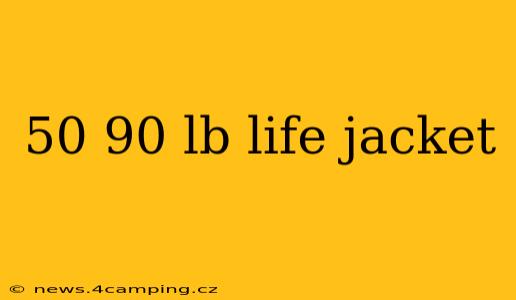Choosing the right life jacket is crucial for water safety, and finding one suitable for a weight range of 50-90 lbs requires careful consideration. This guide will help you navigate the options and select the perfect life jacket for your needs, addressing common questions and concerns.
What Type of Life Jacket is Best for a 50-90 lb Person?
The ideal life jacket for someone weighing between 50 and 90 lbs will depend heavily on their age and the activities they'll be participating in. For children in this weight range, a Type III (Flotation Aid) or Type V (Special Use) life jacket are often the most suitable.
-
Type III (Flotation Aids): These are comfortable and offer good freedom of movement, making them ideal for activities like boating, kayaking, and fishing. They provide buoyancy, turning an unconscious person face-up, but may not be as buoyant as other types. Look for ones specifically designed for children and fitting snugly within the 50-90 lb range.
-
Type V (Special Use): These life jackets are designed for specific activities, such as water skiing or whitewater rafting. They are highly specialized and offer different levels of buoyancy and protection. Carefully check the manufacturer's specifications to ensure it's appropriate for the intended use and the child's weight. A Type V jacket should not be the primary choice unless the child is participating in a very specific activity where it's the recommended PFD.
Important Note: It is crucial to avoid using an adult life jacket on a child. Adult life jackets are designed for a much heavier weight and are likely to be too bulky and cumbersome, potentially restricting movement and even causing drowning.
How Do I Choose the Right Size Life Jacket for a Child Weighing 50-90 lbs?
Always refer to the manufacturer's size chart. Life jackets are not one-size-fits-all. The weight range printed on the jacket must encompass the child's weight. Don't rely solely on age; always check the weight range. Proper fit is paramount to ensure the life jacket functions as intended in an emergency. A life jacket that's too large will be ineffective, while one that's too small will restrict breathing and movement.
Look for these key features:
- Snug Fit: The life jacket should fit snugly but not be restrictive. You should be able to comfortably slip two fingers between the life jacket and the child's chin.
- Proper Straps: All straps should be securely fastened, and the jacket should remain in place even if the child is moving around.
- No Gaps: There should be no significant gaps between the jacket and the child's body.
What Are the Different Types of Life Jackets?
There are five main types of life jackets, each designed for different purposes and activities:
- Type I (Offshore Life Jacket): Provides the highest level of buoyancy and is designed for use in rough waters far from shore. Usually very bulky and not ideal for children.
- Type II (Near-shore Buoyant Vest): Offers good buoyancy and is suitable for calm waters and near-shore activities. Usually less bulky than Type I but still larger than what is needed for a child of this weight.
- Type III (Flotation Aid): Provides comfort and freedom of movement and is suitable for a variety of activities.
- Type IV (Throwable Personal Flotation Device): Designed to be thrown to someone in distress; not worn.
- Type V (Special Use Device): Designed for specific activities, such as waterskiing or whitewater rafting.
Where Can I Buy a 50-90 lb Life Jacket?
Life jackets for children weighing 50-90 lbs are widely available at most sporting goods stores, marine supply stores, and online retailers. Look for reputable brands known for their safety and quality.
How Do I Make Sure My Child's Life Jacket is Properly Maintained?
Regularly inspect your child's life jacket for any signs of wear and tear, such as rips, tears, or loose straps. Follow the manufacturer's instructions for cleaning and storage. Replace any life jacket that shows signs of damage. A well-maintained life jacket is a crucial part of water safety.
Remember, choosing the right life jacket is a matter of safety. Prioritize proper fit and choose a jacket appropriate for the child's weight and the intended water activity. Don't hesitate to seek advice from professionals at a marine supply store or boating safety organization if you need further assistance.
